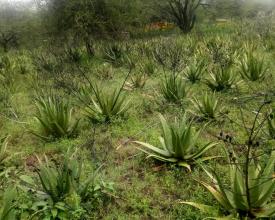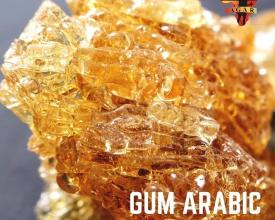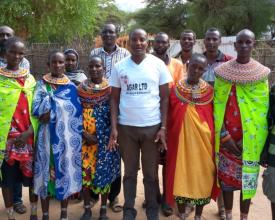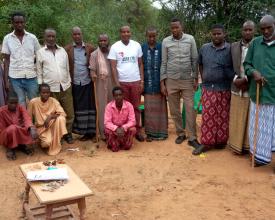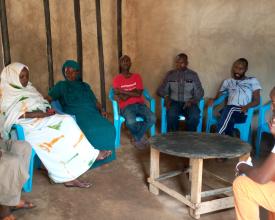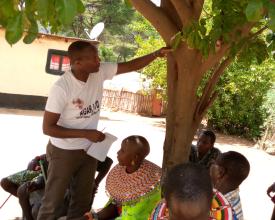
Iniciativa para el desarrollo de la cadena de valor de las tierras áridas de Kenia (KAVADI) ©
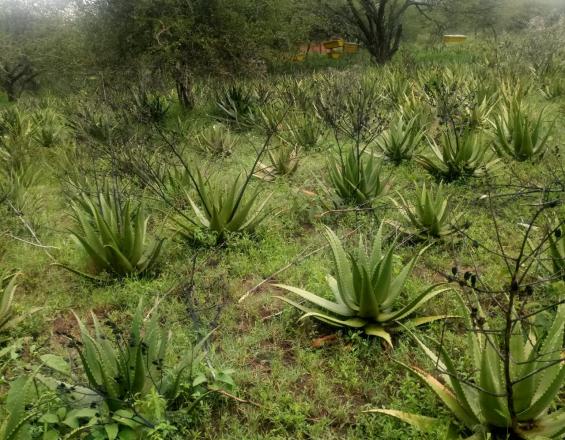
"ASAL - Tierras Áridas y Semiáridas", cubre alrededor del 80% del territorio nacional de Kenia. Los habitantes de estos condados son principalmente comunidades de pastores que cubren vastas zonas. Sin embargo, las tierras áridas y semiáridas de Kenia están dotadas de una rica diversidad de recursos vegetales que exudan goma y resinas.
El enfoque de KAVADI crea capacidad en las tierras áridas mediante la formación de las comunidades en técnicas de recolección silvestre de goma arábiga y otras resinas como el incienso y la mirra, y mediante el cultivo de parcelas de Aloe y las plantaciones piloto de árboles con intereses comerciales. Estos recursos resistentes a la sequía crean oportunidades alternativas de subsistencia, lo que hace que las comunidades sean más resistentes y estén en mejores condiciones de mitigar la vulnerabilidad a la sequía. Además de crear medios de subsistencia, las plantaciones de árboles y plantas resistentes a la sequía regeneran y restauran los paisajes, ya que estas especies se dan bien en terrenos considerados "degradados", por lo que no se utilizan ni para la agricultura tradicional ni para pastos.
Contexto
Défis à relever
- Deforestación
- Cambio climático (desertificación, erosión del suelo)
- Informalidad de los sectores de productos forestales no madereros (PFNM)
- Escasez de inversiones en el sector
Ubicación
Procesar
Resumen del proceso
El objetivo de AGAR es contribuir a la mejora de las condiciones de vida de las comunidades rurales de las zonas áridas y semiáridas, promoviendo un desarrollo socioeconómico inclusivo y sostenible mediante la valorización de los recursos agroforestales de alto potencial, en sinergia con el sector privado local y la agenda nacional.
Para que este concepto funcione eficazmente, nuestros bloques de licitación dependen unos de otros para lograr un impacto satisfactorio:
- Confiando en las buenas asociaciones de todos los actores del sector en sus respectivos papeles para aumentar el potencial productivo de la goma, las resinas y el aloe mediante la acción sinérgica de los sectores público y privado.
- Gestión sostenible de los recursos naturales mediante la introducción de prácticas medioambientales correctas, la mejora de las estrategias de adaptación al cambio climático, la reducción del impacto de la desertificación y la deforestación y la promoción de la inclusión social de las mujeres en los procesos de producción.
- Se realizan formaciones sobre gestión empresarial, rendición de cuentas y ventas dirigidas a la resiliencia económica de las comunidades.
- Formalización de la capacidad sectorial, aumento de la gestión organizativa y financiera y establecimiento de políticas y normas.
Bloques de construcción
Asociaciones, sinergias y colaboraciones
La empresa se ha asociado con actores del sector de la goma y las resinas y de la industria del aloe y los cosméticos para colaborar en el mercado. La asociación con la permacultura de Laikipia ha dado lugar a la creación del vivero de aloe y a la mejora de los productos que los grupos de Laikipia estaban formulando, certificando los productos ecológicos y registrándolos en el Biocomercio Ético. Esto significa que los productos tendrán una demanda mundial, ya que son trazables y de calidad garantizada.
Actualmente, colaboramos estrechamente con el Gobierno del Condado de Isiolo, el Gobierno del Condado de Turkana, el Gobierno del Condado de Marsabit y el Gobierno del Condado de Wajir en Kenia. También colaboramos a menudo con instituciones como la Asociación Forestal de Kenia (KFS), el Instituto de Investigación Forestal de Kenia (KEFRI), la Asociación de la Goma y la Resina (GARA), de cuyo comité ejecutivo somos miembros para garantizar normas de calidad, la Autoridad Nacional de Gestión Medioambiental (NEMA) y el Servicio de Fauna de Kenia (KWS). A lo largo de los años nos hemos asociado con ONG, entre ellas CEFA, COOPI, CESVI, World Vision, VSF-G en Kenia, C&D - Africa Mission en Uganda, y a partir de 2019 con la FAO y el PMA, entre las agencias de la ONU.
Factores facilitadores
- Buenas relaciones de trabajo con la población local.
- Relaciones de trabajo existentes con los agentes del mercado
- Facilitación de la educación sobre gomas y resinas adiciones a la cadena de valor del aloe
- Suministro de herramientas de recolección y clasificación de las materias primas.
- Diversificación de las fuentes de ingresos.
Lección aprendida
- El poder de la colaboración: las buenas relaciones de trabajo con la población local y el gobierno del condado nos han permitido asignar 100 acres de tierras comunitarias para su restauración mediante plantaciones de aloe y especies de gomas y resinas.
- Gracias a la inversión en desarrollo de capacidades que AGAR ha realizado con nuestros socios recolectores y agricultores de aloe, se ha producido una gran mejora en la cantidad y calidad de las materias primas obtenidas, lo que demuestra que con una buena información y técnicas de recolección mejoradas, los agricultores y recolectores pueden hacer un gran trabajo.
- Con múltiples fuentes de ingresos, los hogares de las zonas áridas de Kenia pueden adaptarse a los cambios que conlleva el cambio climático en caso de sequías prolongadas y otras catástrofes naturales, y pueden protegerse de los peligros gracias a fuentes de ingresos diversificadas procedentes de la recolección del áloe, las gomas y las resinas.
- Con buenos socios, tanto del sector público como del privado, es posible mejorar las políticas y directrices que rigen este sector de los productos forestales no madereros.
Biodiversidad, conservación y sostenibilidad
La plantación de árboles de alto potencial de interés comercial, como la Acacia Senegal para la goma arábiga, la Boswelia Neglecta para el incienso y especies autóctonas de aloe (Turkanensis, Secundiflora) en las tierras áridas de Kenia ha contribuido a mejorar la gestión de los recursos naturales por parte de los miembros de la asociación forestal de los bosques comunitarios, que ayudamos a formar, y que actúan como guardianes del medio ambiente, además de recibir formación sobre prácticas correctas de gestión medioambiental.
La recuperación de la biodiversidad local y el uso de técnicas agroecológicas innovadoras por parte de las comunidades locales de las zonas áridas mejora sus estrategias de adaptación al cambio climático, reduciendo así el impacto de la desertificación, provocada por la deforestación generalizada para quemar carbón como fuente de ingresos diversa, aparte del pastoreo, que es la principal fuente de ingresos de la población de las regiones áridas y ha hecho que las comunidades dependan de la ayuda en épocas de sequía.
Gracias al desarrollo de nuestras capacidades, las comunidades han podido mejorar sus competencias en materia de gestión sostenible de los recursos naturales mediante la introducción de prácticas medioambientales correctas, la mejora de las estrategias de adaptación al cambio climático y la reducción del impacto de la desertificación y la deforestación.
Factores facilitadores
- Disponibilidad de grandes parcelas de tierra para la restauración
- Disponibilidad de especies vegetales que puedan sobrevivir en zonas áridas y utilizarse para generar ingresos.
- Disponibilidad de técnicas y especialistas que enseñen a restaurar sus tierras.
- Aceptación del aprendizaje y la colaboración de la población local.
- Desarrollo de capacidades sobre la forma correcta de cultivar, cosechar y recolectar materias primas de aloe y gomas y resinas.
- Colaboración de nuestros socios, como los gobiernos de los condados, para asignar tierras comunitarias ociosas a la conservación ecológica.
Lección aprendida
- Las especies vegetales endémicas de las zonas áridas pueden utilizarse para conservar y restaurar el ecosistema.
- Los miembros de la comunidad pueden proteger sus propios ecosistemas con métodos de conservación tanto autóctonos como científicos.
- La colaboración entre agentes privados y gubernamentales puede dar resultados positivos en la conservación ecológica.
- El cultivo de especies autóctonas y su cuidado pueden suponer una fuente de ingresos diversificada.
- Las zonas áridas son ricas en recursos naturales que, bien mantenidos, pueden utilizarse para generar ingresos.
Desarrollo de capacidades y resiliencia
El principal objetivo de AGAR en materia de desarrollo de capacidades es contribuir a la mejora de las condiciones de vida de las comunidades rurales en tierras áridas y semiáridas mediante la promoción de un desarrollo socioeconómico inclusivo y sostenible a través de la mejora de los recursos agroforestales de alto potencial, en sinergia con el sector privado local y la agenda nacional. Para ello, impartimos formación y seminarios sobre cadenas de valor agroforestales sostenibles desde el punto de vista medioambiental a los miembros de las comunidades:
- Gestión sostenible de los recursos naturales
- Propagación, trasplante, recolección y formulación de aloe y sus productos
- Recolección, selección y clasificación de gomas y resinas
- Suministro de herramientas de recolección y clasificación de gomas y resinas
- Almacenamiento de gomas y resinas
- Principios empresariales y desarrollo
Con estas formaciones las comunidades
- Aumentar la resiliencia económica gracias a una fuente alternativa de ingresos.
- Construir comunidades fuertes e independientes a través de la provisión de oportunidades de trabajo,
- Mejorar las estrategias de adaptación al cambio climático,
- Reducen el impacto de la desertificación y la deforestación y
- Promover la inclusión social de las mujeres, los jóvenes y las personas con discapacidad en los procesos de producción.
Factores facilitadores
- Disponibilidad de conocimientos y recursos de formación
- Disponibilidad de agricultores y recolectores que puedan recibir formación sobre el valor añadido.
- Disponibilidad de un mercado preparado que exija productos de calidad, de ahí la formación para obtener materias primas de calidad.
- Disponibilidad de mano de obra
- Disponibilidad de recursos naturales, como la tierra.
- Disponibilidad para aprender de la comunidad
- Aceptación del proyecto por parte de las comunidades, los gobiernos locales y los socios comerciales.
Lección aprendida
- Las asociaciones saludables con las comunidades locales pueden dar lugar a un notable progreso medioambiental y económico.
- Con la colaboración de todos los agentes del sector, se logran grandes avances en el desarrollo del sector de las gomas y resinas, lo que abre la puerta a mejores políticas y normativas que garanticen la gestión de calidad de los productos madereros no forestales.
- Para obtener un buen producto final, hay que cuidar bien las plantas y los árboles, para mejorar la calidad del producto final, de ahí la gran inversión en capacitación.
- Hay que incorporar nuevas técnicas de cultivo y recolección para obtener productos finales de calidad.
Impactos
- Actividades de generación de ingresos a partir de cadenas de valor agroforestales
cadenas de valor agroforestales alternativas y sostenibles - Acceso a los mercados para los sectores emergentes a través del fortalecimiento de los vínculos con actores públicos y privados, con el fin de construir alianzas estratégicas para la promoción y comercialización de productos;
- Restauración de 100 a 200 acres de tierras degradadas mediante el uso de árboles y plantas resistentes a la sequía (especies de aloe, acacia y boswellia).
Beneficiarios
El concepto KAVADI se ha diseñado para garantizar que las comunidades más vulnerables de la región, como:
- Pastores
- Mujeres
- Jóvenes
- Personas con discapacidad
Objetivos de Desarrollo Sostenible
Historia
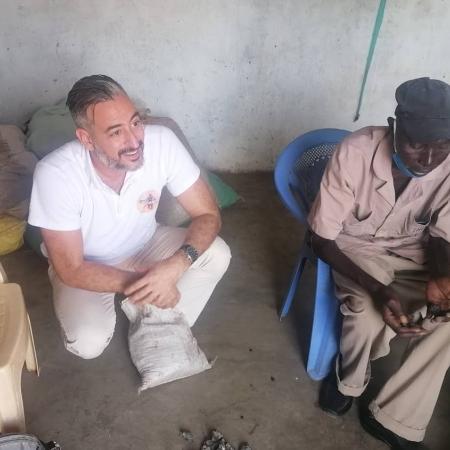
Antes de fundar Agar Limited, yo (Tommaso Menini - Director) trabajé durante varios años en tierras áridas como especialista en desarrollo empresarial con varias ONG: durante este tiempo, he visto un sinfín de iniciativas destinadas a fortalecer las microeconomías a través de actividades de generación de ingresos. Lo que les faltaba a todas estas iniciativas, incluido el proyecto financiado por la UE que dirigí personalmente en Isiolo durante dos años y medio, era la participación del sector privado desde la fase de diseño. En la mayoría de los proyectos ,el sector privado sólo participaba al final, cuando se buscaba una estrategia de salida. Creemos que el desarrollo verdaderamente sostenible sólo puede lograrse identificando oportunidades de mercado y ayudando a los grupos marginados a desarrollar habilidades y capacidades para establecer asociaciones con empresas dinámicas en condiciones equitativas.
Diseñé KAVADI© pensando en la base de la pirámide de nuestro comercio, las comunidades de las tierras áridas, que se beneficiarían de una estructura que ninguna iniciativa de desarrollo ha logrado construir hasta ahora. Con esto en mente, me reincorporé al sector privado en 2017 después de casi 10 años trabajando en el sector de la ayuda reactivando una empresa que se ocupa de los recursos naturales en el noreste de Kenia, abogando por prácticas medioambientales adecuadas y el empoderamiento socioeconómico de las comunidades de pastores a través de la diversificación de los ingresos y, últimamente, el uso de plantas y árboles resistentes a la sequía como medio para restaurar las tierras degradadas.
En 2018 fundé "African Agency for Arid Resources Ltd", una empresa especializada en especies arbóreas de tierras áridas,empoderamientosocioeconómico en tierras áridas, desarrollo de recursos naturales y conservación medioambiental, y en 2019 me convertí en consultora de la ONU para un proyecto que trabaja en 4 condados ASAL de Kenia en restauración de tierras y desarrollo de bioemprendimientos, al que contribuyo actualmente.
